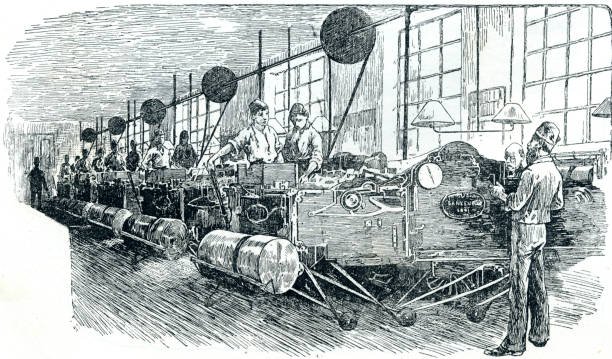On this page, we name four things the economy of Britain was based on prior to the Industrial Revolution.
Before the Industrial Revolution fundamentally transformed society, the economy of Britain was grounded in several key sectors. Agriculture dominated, serving as the livelihood for the vast majority of the population.
Alongside, the textile industry, driven by the widespread availability of wool, was a crucial part of the economic landscape. Trade also played a pivotal role, with Britain leveraging its geographic advantage to establish a global trading network.
Lastly, the cottage industry represented a significant portion of production, with goods being manufactured in homes across the countryside. These sectors collectively formed the economic foundation that would fuel the Industrial Revolution, marking a pivotal shift in Britain’s economic and social structure.
FOUR Things the Economy of Britain was Based on Prior to the Industrial Revolution
Here’s a quick rundown of what the British economy was largely based on before the Industrial Revolution kicked into full gear:
1. 🌾 Agriculture
Agriculture was the backbone of the economy. Most people lived in rural areas and relied on farming for their livelihood. This period saw the beginning of agricultural advancements that would later contribute to the Agricultural Revolution, improving crop yields and farming techniques.
- Enclosure Acts: Laws that allowed for the consolidation of common lands into individual plots, significantly altering the landscape of British agriculture. This move towards privatized land ownership increased efficiency and production, laying groundwork for the Industrial Revolution.
- Wool Production: Wool was a major export product for Britain, with its quality sheep breeds. The thriving wool trade underscored the importance of agriculture to the economy of Britain prior to industrialization.
- Crop Rotation Systems: The introduction of turnip and clover crops allowed for more sustainable soil management and higher yields, illustrating agricultural innovation before the Industrial Revolution.
- Common Lands: Before the Enclosure Acts, common lands were used collectively by villagers for grazing livestock and growing crops. The management and use of these lands were a fundamental part of rural economies.
2. 🐑 Textiles
The production of textiles, especially wool, played a significant role. Britain’s extensive sheep farming provided the raw materials needed for weaving woolen goods, which were in high demand both domestically and abroad.
- Woolen Goods: Britain was renowned for its high-quality woolen cloth, a staple of its textile industry. Towns like Norwich and Worchester became centers for woolen textile production.
- Linen Production: Besides wool, linen was another important textile, made from flax. Places like Scotland and Ireland were key linen production areas, contributing to the textile sector of the economy.
- Cottage Spinning and Weaving: Households across the country engaged in spinning wool and weaving textiles, a precursor to the factory-based production that would characterize the Industrial Revolution.
- Merchants and Cloth Fairs: Merchants played a crucial role in the textile industry, distributing raw materials and finished goods. Cloth fairs, such as the one in Leeds, were essential for trade.
3. 🚢 Trade
Trade was a major component, with Britain’s position as an island nation facilitating its role in maritime trade. The country traded goods like wool, coal, and later, manufactured products, establishing a global trade network that reached the Americas, India, and beyond.
- The East India Company: Established to pursue trade with the East Indies but ended up trading mainly with the Indian subcontinent and China. This company was a pillar in developing Britain’s trade empire before the Industrial Revolution.
- The Triangular Trade: A system of trading in which a country pays for its imports from one country by its exports to another. It involved trading goods for slaves in Africa, transporting those slaves to the Americas, then trading them for raw materials to bring back to Britain.
- British Ports: Ports like Liverpool and Bristol flourished as trade hubs, supporting the economy with their busy docks filled with goods from around the world, setting the stage for the global economic integration that would follow.
- Wool Export: Wool was not just a domestic staple but also a significant export commodity, demonstrating the global reach of Britain’s pre-industrial economy.
4. 🏭 Cottage Industry
Before the advent of factory systems, the cottage industry was prevalent. This involved the production of goods at home, such as textiles, leather goods, and metalware. It was labor-intensive and spread out across rural households, but it set the stage for the mechanization and centralization of production during the Industrial Revolution.
- Handloom Weaving: Weavers worked from their homes, producing textiles with techniques passed down through generations. This craft was a cornerstone of local economies and provided the template for the mechanized textile production that would define the Industrial Revolution.
- Blacksmithing: Local blacksmiths were vital for the production of tools, horseshoes, and small metal goods, serving both agricultural and domestic needs. Their work exemplified the skilled craftsmanship prevalent before industrial mass production.
- Pottery and Ceramics: Towns such as Stoke-on-Trent became centers for pottery and ceramics, with families specializing in these crafts. The industry’s structure would later evolve with industrial methods.
- Lace-making: Lace-making was another detailed craft performed in homes across Britain. The intricate work required skill and time, making it a valued commodity both domestically and internationally.
These sectors formed the economic foundation that the Industrial Revolution would later transform, leading Britain to become the world’s leading industrial power.
From all of the above, it is evident that the economy of Britain prior to the Industrial Revolution was a diverse and intricate tapestry woven from agriculture, textiles, trade, and the cottage industry. Each sector played a critical role in laying the foundation for the monumental shifts that the Industrial Revolution would bring. The Enclosure Acts reshaped agriculture, making it more efficient and ready for industrial farming methods. The textile industry, deeply rooted in wool and linen production, was poised for the mechanization that would revolutionize fabric production. Trade, bolstered by entities like the East India Company and the Triangular Trade, positioned Britain as a global economic powerhouse, ready to expand further with industrialization. Lastly, the cottage industry’s personalized and skilled craftsmanship provided the initial workforce and expertise that would be scaled up in factories and mills.
These components underscored the complexity of Britain’s pre-industrial economy and set the stage for the country to lead the world into the industrial age. The transition was not just a matter of technological innovation; it was built upon the economic practices, social structures, and cultural norms that had developed over centuries. As Britain moved into the era of steam engines, mechanized looms, and ironworks, it was these foundational sectors that transformed, merged, and evolved, driving the country into a new epoch of industrial and economic dominance. The legacy of this era is a testament to the enduring impact of these early economic activities on the course of global history.





